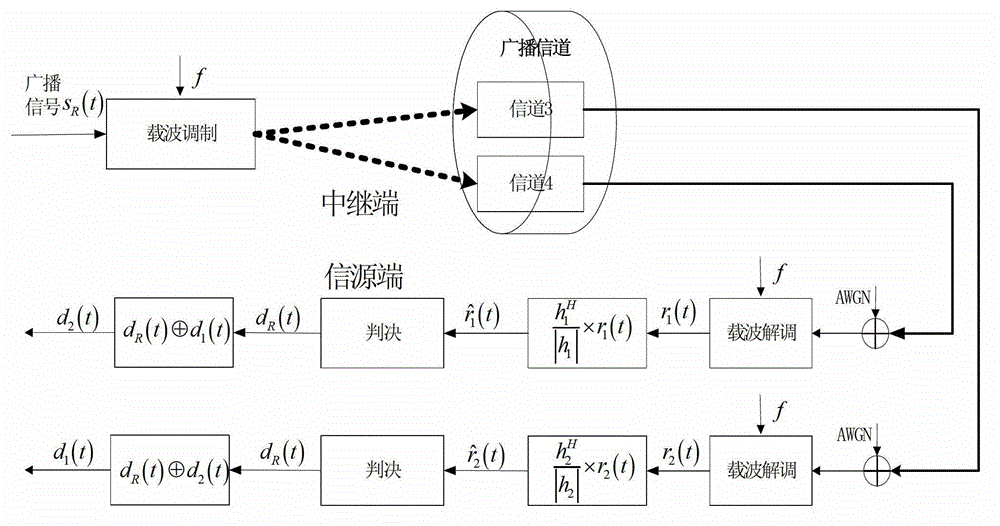Wireless communication method for physical network coding in flat frequency-selective fading channel, based on two-way relay model
A two-way relay, fading channel technology, applied in the direction of digital transmission system, electrical components, error prevention, etc.
- Summary
- Abstract
- Description
- Claims
- Application Information
AI Technical Summary
Problems solved by technology
Method used
Image
Examples
specific Embodiment approach 1
[0032] Specific implementation mode 1. Combination figure 1 , figure 2 and image 3 Describe this embodiment, the wireless communication method of physical layer network coding in the flat frequency selective fading channel based on two-way relay model described in this embodiment, the specific implementation steps of this method are:
[0033] Step 1. In the first time slot, the source nodes S1 and S2 respectively compare the input information data d 1 (t) and d 2 (t) Perform QPSK modulation to obtain the modulated signal s 1 (t) and s 2 (t);
[0034] Step 2. The source nodes S1 and S2 respectively convert the modulated signal s obtained in Step 1 1 (t) and s 2 (t) Perform precoding to obtain the precoded signal x 1 (t) and x 2 (t);
[0035] Step 3. The precoded signal x to be obtained by source nodes S1 and S2 1 (t) and x 2 (t) Perform carrier modulation to obtain a carrier-modulated signal, and simultaneously send the obtained carrier-modulated signal to the re...
specific Embodiment approach 2
[0046] Specific embodiment 2. This embodiment is a further description of the wireless communication method of physical layer network coding in a flat frequency-selective fading channel based on the two-way relay model described in specific embodiment 1. The precoding described in step 2 is obtained after signal x 1 (t) and x 2 (t) by the formula:
[0047] x 1 ( t ) = w 1 s 1 ( t ) x 2 ( t ) = w ...
specific Embodiment approach 3
[0051] Specific Embodiment 3. This embodiment is a further description of the wireless communication method for physical layer network coding in a flat frequency-selective fading channel based on the two-way relay model described in Embodiment 1. The carrier solution is obtained in step 4. modulated sum signal r R (t) by the formula:
[0052] r R (t)=(|h 1 |x 1 (t)+|h 2 |x 2 (t))+n 0 (3)
[0053] Calculated, where, n 0 is additive white Gaussian noise, h 1 and h 2 are the channel coefficients from source node S1 and source node S2 to relay node SR, respectively.
PUM
 Login to View More
Login to View More Abstract
Description
Claims
Application Information
 Login to View More
Login to View More - R&D
- Intellectual Property
- Life Sciences
- Materials
- Tech Scout
- Unparalleled Data Quality
- Higher Quality Content
- 60% Fewer Hallucinations
Browse by: Latest US Patents, China's latest patents, Technical Efficacy Thesaurus, Application Domain, Technology Topic, Popular Technical Reports.
© 2025 PatSnap. All rights reserved.Legal|Privacy policy|Modern Slavery Act Transparency Statement|Sitemap|About US| Contact US: help@patsnap.com



